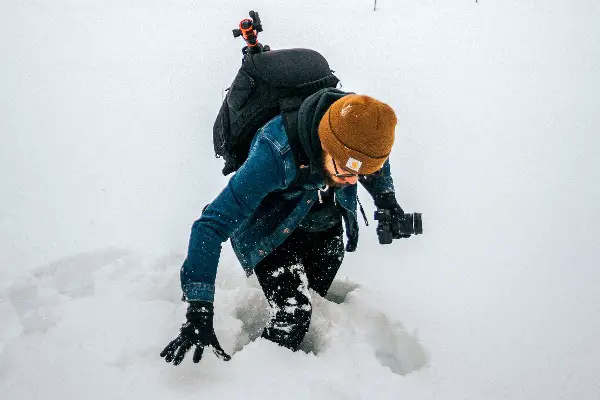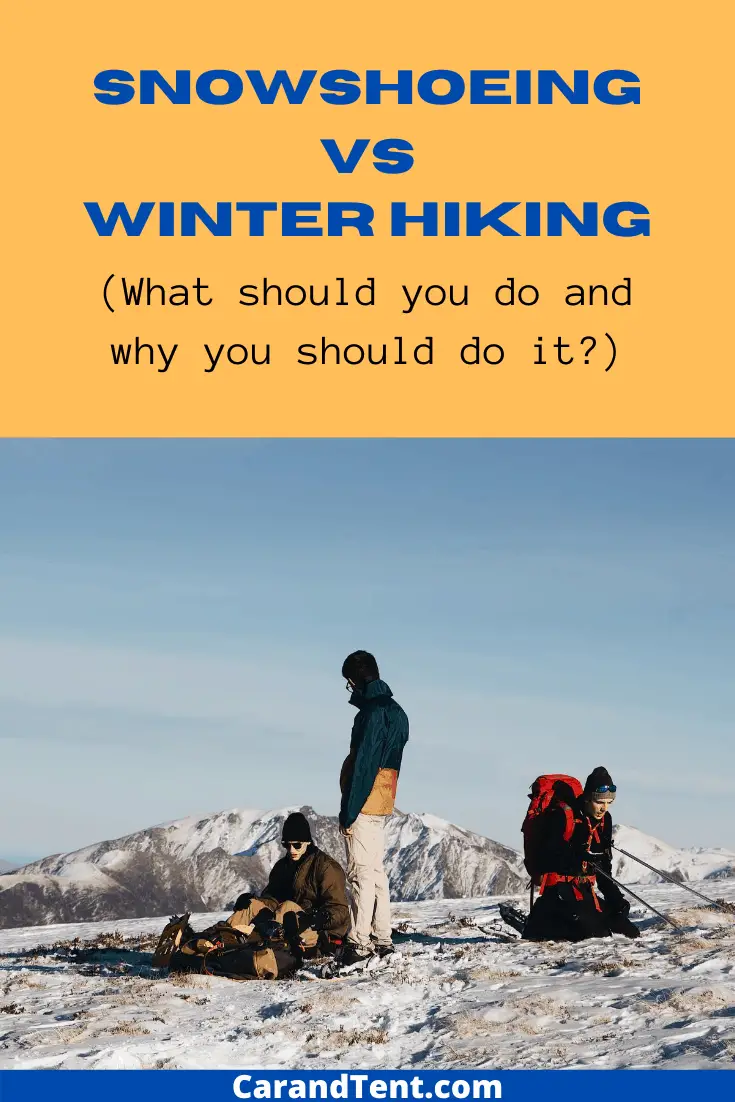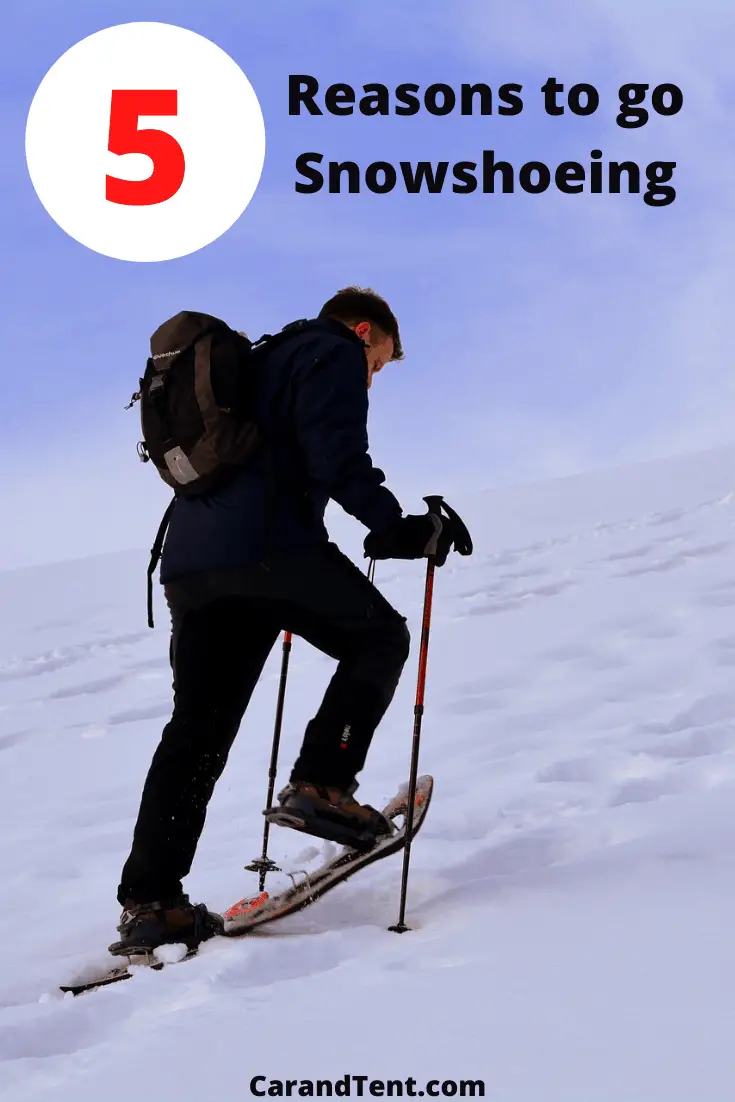
I used to love hiking in the snow. In fact, I still love it. But over the past few years, I’ve also come to fall in love with snowshoeing as well.
I’ve found that snowshoeing and hiking both have their advantages and disadvantages and sometimes it’s best to choose one over the other. In this post, I’ll go over the pros and cons of snowshoeing vs hiking in the snow so that you can get a better feel for what you might prefer.
Table of Contents
Snowshoeing
Snowshoeing offers a few advantages over hiking in the snow. Here are some of the pros of snowshoeing.
- Snowshoeing gives you a better workout than hiking.
- Snowshoes allow you to hike in deep snow.
- Snowshoes can provide a better grip on slippery surfaces.
- Snowshoeing is slower.
- Snowshoes offer you the chance to do something new.
Snowshoeing Is a Great Workout
Snowshoeing requires a lot more effort than hiking. There are a few reasons for this.
For starters, each snowshoe weighs a few pounds by itself. This may not sound like a lot but weight added to your feet has a direct impact on each step. It’s basically like doing a lightweight leg lift every time you walk. On top of this, snow can often cover the snowshoes which places additional weight on your feet.
Snowshoes also force you to change your stride. The reason for this is that snowshoes are wide enough to make you change your gait or risk bumping your feet together. This small change in stride works your leg muscles differently and makes walking less efficient.
All of this adds up to a lot more calories burned when snowshoeing instead of hiking. In fact, it’s been said that just one hour of snowshoeing can burn up to 1,000 calories! To put it in contrast, hiking only burns about 432 calories an hour. You can read more about that at https://www.carandtent.com/health-benefits-of-hiking/.
Snowshoeing Can Be Done In Deep Snow
Snowshoes allow snowshoers to float over deep snow without sinking to the ground. This is especially true in thick snow that has had a chance to harden. As a result, you can go places that you wouldn’t be able to go without snowshoes.
This can lead to a quieter trip further away from people and civilization. It also offers up more off-trail experiences as you’ll be able to go places that would normally be inaccessible on foot during the warmer months.
Snowshoes Offer Superior Grip
Snowshoes will usually have a cleat that helps provide additional grip and traction. This makes ascents and descents over snow-covered hills and valleys much easier and safer.
On top of this, some snowshoes come with retractable bars that can be flipped into place to provide additional grip. These types of snowshoes are great for people who may not always want to have a large cleat protruding from their snowshoes.
Snowshoeing Is Slower and Faster
It just isn’t possible to snowshoe as fast as you can hike in shallow snow. This means that even short hiking trails can provide you with a nice long day outdoors.
On the flip side, a good pair of snowshoes will allow you to move faster through heavy snowdrifts. While you’re floating above the snowdrifts on your snowshoes, hikers have to navigate through waist-deep snow. This gives you the ability to get further out on the hiking trails even after a heavy snowfall.

Snowshoeing Breaks Up The Monotony
Hiking is great but sometimes it’s good to do something new. Snowshoes allow you to explore your favorite hiking trails while engaging in a fun and different activity.
The same thing can be said of mountain biking and xc skiing, but neither of these activities is as flexible or as close to hiking as snowshoeing is. If you’re a hiker looking to try something new, I’d strongly recommend you give snowshoeing a try.
Hiking
Now that we’ve explored some of the advantages of using snowshoes in snow, let’s take a look at some of the advantages of just hiking through the snow instead.
- Hiking is easier.
- Hiking is cheaper.
- Hiking allows you to travel greater distances in less time.
- Hiking doesn’t require a certain amount of snow.
Hiking Is Easier
Hiking through shallow snow is a lot easier than snowshoeing through it. In fact, on my last snowshoeing trip through about 10 inches of snow, I ended up getting tired and carrying my snowshoes back with me. Snowshoeing can quickly take a lot out of you and after just a few miles you might end up having to call it quits.
This is especially good to know when you’re looking to take on a long hiking trail in light snow. A good pair of hiking boots will allow you to finish the trail much sooner than a pair of snowshoes and with a lot more energy to spare when it’s finished.
Hiking Is Less Expensive
I wouldn’t consider snowshoeing an expensive activity. In fact, I got my first pair of snowshoes for just $40.00 off Craigslist. You can read about them at https://www.carandtent.com/atlas-930-snowshoe-review/.
This being said, snowshoes do cost money and that is an additional cost to consider. Also, depending on the snow you’ll be walking through, you may have to get a pair of poles as well. These don’t cost a lot of money either, but they do add to the cost of snowshoeing.

On the other hand, hiking is essentially free. Even if you don’t have a good pair of hiking boots, you can probably go hiking through light snow in a good pair of trail runners. For many years I went hiking through the snow in just a good pair of running shoes and a warm pair of socks and I enjoyed every minute of it.
Hiking Allows You to Go Further
As I mentioned earlier, hiking is a lot easier than snowshoeing in shallow snow. This allows you to take on longer hikes. In the end, you may end up getting a quieter hike without the snowshoes because you’ll be able to get further out on the trail than the folks that are using them.
Hiking Is Better For Small Amounts of Snow
It’s recommended that you have at least 6″ of snow on the ground before you put your snowshoes on. This can really limit the number of days some people can use their snowshoes. When I was living in Philadelphia I found that some years would provide me with many days of snowshoeing while other years might only offer deep enough snow for a day, if at all.
With snow hiking, you don’t have this problem. You can hike in the snow from one inch all the way up to about 12 inches without too much difficulty.
Which Should You Choose, Hiking or Snowshoeing
Hopefully, the answer is obvious after reading this article – you should do both! Get a good pair of hiking boots or hiking shoes with nice traction and use them anytime the snowfall is below six inches. When you’re lucky enough to get more snow than 6 inches, go snowshoeing instead.



